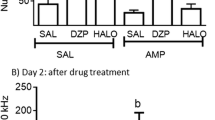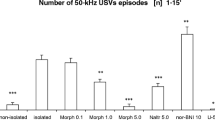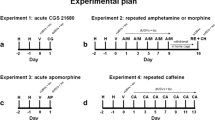Abstract
Although previous studies have suggested an association between unpleasant sounds and the use of drugs, scientific evidence supporting this is lacking. This study investigated in rats (male Sprague-Dawley rats) if aversive sounds modulate dopamine (DA) transmission in the mesolimbic reward system and cocaine reinforcement. For sound stimulation, we used artificial low-frequency ultrasound (ALFUS) in the frequency ranges (22–38 kHz) which produces an aversive response in rats. Rats displayed increased anxiety-like behaviors, 22-kHz ultrasonic vocalizations (USVs), and stress responses with ALFUS. In vivo extracellular recording and immunohistochemistry revealed that ALFUS stimulation activated central amygdalar neurons and amygdalar GABAergic neurons. Amygdalar lesions prevented an increase of 22-kHz USVs by ALFUS. Dopamine levels in NAc decreased during ALFUS stimulation. In rats self-administering cocaine, ALFUS caused reinstatement of cocaine seeking after a period of extinction. Thus, ALFUS stimulation induced negative emotional states in association with a decrease in mesolimbic DA function and reinstatement of cocaine-seeking behaviors, suggesting that exposure to unpleasant sounds enhances negative emotional states and may induce relapse in addicts.





Similar content being viewed by others
References
Hamann SB, Ely TD, Hoffman JM, Kilts CD (2002) Ecstasy and agony: activation of the human amygdala in positive and negative emotion. Psychol Sci 13(2):135–141. https://doi.org/10.1111/1467-9280.00425
Kumar S, von Kriegstein K, Friston K, Griffiths TD (2012) Features versus feelings: dissociable representations of the acoustic features and valence of aversive sounds. J Neurosci 32(41):14184–14192. https://doi.org/10.1523/JNEUROSCI.1759-12.2012
Zald DH, Pardo JV (2002) The neural correlates of aversive auditory stimulation. NeuroImage 16(3 Pt 1):746–753
Ompad D, Fuller C (2005) The urban environment, drug use, and health. In: Handbook of Urban Health. Springer, pp 127–154. https://doi.org/10.1007/0-387-25822-1_7
Stansfeld S, Gallacher J, Babisch W, Shipley M (1996) Road traffic noise and psychiatric disorder: prospective findings from the Caerphilly Study. BMJ 313(7052):266–267
Stansfeld SA, Matheson MP (2003) Noise pollution: non-auditory effects on health. Br Med Bull 68:243–257
Stasiewicz PR, Lisman SA (1989) Effects of infant cries on alcohol consumption in college males at risk for child abuse. Child Abuse Negl 13(4):463–470
Koob GF (2015) The dark side of emotion: the addiction perspective. Eur J Pharmacol 753:73–87. https://doi.org/10.1016/j.ejphar.2014.11.044
Barker DJ, Bercovicz D, Servilio LC, Simmons SJ, Ma S, Root DH, Pawlak AP, West MO (2014) Rat ultrasonic vocalizations demonstrate that the motivation to contextually reinstate cocaine-seeking behavior does not necessarily involve a hedonic response. Addict Biol 19(5):781–790. https://doi.org/10.1111/adb.12044
Heilig M, Egli M, Crabbe JC, Becker HC (2010) Acute withdrawal, protracted abstinence and negative affect in alcoholism: are they linked? Addict Biol 15(2):169–184. https://doi.org/10.1111/j.1369-1600.2009.00194.x
El Hage C, Rappeneau V, Etievant A, Morel AL, Scarna H, Zimmer L, Berod A (2012) Enhanced anxiety observed in cocaine withdrawn rats is associated with altered reactivity of the dorsomedial prefrontal cortex. PLoS One 7(8):e43535. https://doi.org/10.1371/journal.pone.0043535
Markou A, Koob GF (1991) Postcocaine anhedonia. An animal model of cocaine withdrawal. Neuropsychopharmacology 4(1):17–26
Sinha R, Fox HC, Hong KA, Bergquist K, Bhagwagar Z, Siedlarz KM (2009) Enhanced negative emotion and alcohol craving, and altered physiological responses following stress and cue exposure in alcohol dependent individuals. Neuropsychopharmacology 34(5):1198–1208. https://doi.org/10.1038/npp.2008.78
Galea S, Nandi A, Vlahov D (2004) The social epidemiology of substance use. Epidemiol Rev 26:36–52
Knipschild P, Oudshoorn N (1977) VII. Medical effects of aircraft noise: drug survey. Int Arch Occup Environ Health 40(3):197–200
Kupferschmidt DA, Brown ZJ, Erb S (2011) A procedure for studying the footshock-induced reinstatement of cocaine seeking in laboratory rats. J Vis Exp (47). doi:https://doi.org/10.3791/2265
Gilpin NW, Herman MA, Roberto M (2015) The central amygdala as an integrative hub for anxiety and alcohol use disorders. Biol Psychiatry 77(10):859–869. https://doi.org/10.1016/j.biopsych.2014.09.008
Venniro M, Caprioli D, Zhang M, Whitaker LR, Zhang S, Warren BL, Cifani C, Marchant NJ et al (2017) The anterior insular cortex→ central amygdala glutamatergic pathway is critical to relapse after contingency management. Neuron 96(2):414–427.e418
Goosens KA, Maren S (2001) Contextual and auditory fear conditioning are mediated by the lateral, basal, and central amygdaloid nuclei in rats. Learn Mem 8(3):148–155
Manohar S, Spoth J, Radziwon K, Auerbach BD, Salvi R (2017) Noise-induced hearing loss induces loudness intolerance in a rat Active Sound Avoidance Paradigm (ASAP). Hear Res 353:197–203. https://doi.org/10.1016/j.heares.2017.07.001
Valdez GR, Sabino V, Koob GF (2004) Increased anxiety-like behavior and ethanol self-administration in dependent rats: reversal via corticotropin-releasing factor-2 receptor activation. Alcohol Clin Exp Res 28(6):865–872
Kim NJ, Ryu Y, Lee BH, Chang S, Fan Y, Gwak YS, Yang CH, Bills KB, Steffensen SC, Koo JS (2018) Acupuncture inhibition of methamphetamine-induced behaviors, dopamine release and hyperthermia in the nucleus accumbens: mediation of group II mGluR. Addict Biol 24(2):206–217
Kim DH, Ryu YH, Hahm DH, Sohn BY, Shim I, Kwon OS, Chang S, Gwak YS, Kim MS, Kim JH, Lee BH, Jang EY, Zhao RJ, Chung JM, Yang CH, Kim HY (2017) Acupuncture points can be identified as cutaneous neurogenic inflammatory spots. Sci Rep in press. doi:https://doi.org/10.1038/s41598-017-14359-z
Jin W, Kim MS, Jang EY, Lee JY, Lee JG, Kim HY, Yoon SS, Lee BH et al (2018) Acupuncture reduces relapse to cocaine-seeking behavior via activation of GABA neurons in the ventral tegmental area. Addict Biol 23(1):165–181. https://doi.org/10.1111/adb.12499
Paxinos G, Watson C (2007) The rat brain in stereotaxic coordinates in stereotaxic coordinates, 6th edn. Academic Press, San Diego
Pang YY, Chen XY, Xue Y, Han XH, Chen L (2015) Effects of secretin on neuronal activity and feeding behavior in central amygdala of rats. Peptides 66:1–8. https://doi.org/10.1016/j.peptides.2015.01.012
Chang S, Ryu Y, Gwak YS, Kim NJ, Kim JM, Lee JY, Kim SA, Lee BH et al (2017) Spinal pathways involved in somatosensory inhibition of the psychomotor actions of cocaine. Sci Rep 7(1):5359. https://doi.org/10.1038/s41598-017-05681-7
Jang EY, Ryu YH, Lee BH, Chang SC, Yeo MJ, Kim SH, Folsom RJ, Schilaty ND et al (2015) Involvement of reactive oxygen species in cocaine-taking behaviors in rats. Addict Biol 20(4):663–675. https://doi.org/10.1111/adb.12159
Marek R, Strobel C, Bredy TW, Sah P (2013) The amygdala and medial prefrontal cortex: partners in the fear circuit. J Physiol 591(10):2381–2391
Borta A, Wohr M, Schwarting RK (2006) Rat ultrasonic vocalization in aversively motivated situations and the role of individual differences in anxiety-related behavior. Behav Brain Res 166(2):271–280. https://doi.org/10.1016/j.bbr.2005.08.009
Brudzynski SM (2013) Ethotransmission: communication of emotional states through ultrasonic vocalization in rats. Curr Opin Neurobiol 23(3):310–317. https://doi.org/10.1016/j.conb.2013.01.014
Kim EJ, Kim ES, Covey E, Kim JJ (2010) Social transmission of fear in rats: the role of 22-kHz ultrasonic distress vocalization. PLoS One 5(12):e15077. https://doi.org/10.1371/journal.pone.0015077
Wöhr M, Schwarting RK (2007) Ultrasonic communication in rats: can playback of 50-kHz calls induce approach behavior? PLoS One 2(12):e1365
Noble RE (2002) Diagnosis of stress. Metab Clin Exp 51(6 Suppl 1):37–39
Aseltine RH Jr, Gore S, Gordon J (2000) Life stress, anger and anxiety, and delinquency: an empirical test of general strain theory. J Health Soc Behav 41(3):256–275
Fiedler N, Laumbach R, Kelly-McNeil K, Lioy P, Fan ZH, Zhang J, Ottenweller J, Ohman-Strickland P et al (2005) Health effects of a mixture of indoor air volatile organics, their ozone oxidation products, and stress. Environ Health Perspect 113(11):1542–1548
Lee PS, Sohn JN, Lee YM, Park EY, Park JS (2005) A correlational study among perceived stress, anger expression, and depression in cancer patients. Taehan Kanho Hakhoe Chi 35(1):195–205
Daniels W, Richter L, Stein D (2004) The effects of repeated intra-amygdala CRF injections on rat behavior and HPA axis function after stress. Metab Brain Dis 19(1–2):15–23
Bressan RA, Crippa JA (2005) The role of dopamine in reward and pleasure behaviour--review of data from preclinical research. Acta Psychiatr Scand Suppl 111(427):14–21. https://doi.org/10.1111/j.1600-0447.2005.00540.x
Albein-Urios N, Verdejo-Roman J, Asensio S, Soriano-Mas C, Martinez-Gonzalez JM, Verdejo-Garcia A (2014) Re-appraisal of negative emotions in cocaine dependence: dysfunctional corticolimbic activation and connectivity. Addict Biol 19(3):415–426. https://doi.org/10.1111/j.1369-1600.2012.00497.x
Witkiewitz K, Villarroel NA (2009) Dynamic association between negative affect and alcohol lapses following alcohol treatment. J Consult Clin Psychol 77(4):633–644. https://doi.org/10.1037/a0015647
Shiffman S, Waters AJ (2004) Negative affect and smoking lapses: a prospective analysis. J Consult Clin Psychol 72(2):192–201. https://doi.org/10.1037/0022-006X.72.2.192
Logrip ML, Zorrilla EP, Koob GF (2012) Stress modulation of drug self-administration: implications for addiction comorbidity with post-traumatic stress disorder. Neuropharmacology 62(2):552–564. https://doi.org/10.1016/j.neuropharm.2011.07.007
Erb S, Shaham Y, Stewart J (1996) Stress reinstates cocaine-seeking behavior after prolonged extinction and a drug-free period. Psychopharmacology 128(4):408–412
Shaham Y, Stewart J (1995) Stress reinstates heroin-seeking in drug-free animals: an effect mimicking heroin, not withdrawal. Psychopharmacology 119(3):334–341
LeDoux JE (2014) Coming to terms with fear. Proc Natl Acad Sci U S A 111(8):2871–2878. https://doi.org/10.1073/pnas.1400335111
Mahan AL, Ressler KJ (2012) Fear conditioning, synaptic plasticity and the amygdala: implications for posttraumatic stress disorder. Trends Neurosci 35(1):24–35. https://doi.org/10.1016/j.tins.2011.06.007
Warlow SM, Robinson MJF, Berridge KC (2017) Optogenetic central amygdala stimulation intensifies and narrows motivation for cocaine. J Neurosci 37(35):8330–8348. https://doi.org/10.1523/JNEUROSCI.3141-16.2017
Ahn S, Phillips AG (2002) Modulation by central and basolateral amygdalar nuclei of dopaminergic correlates of feeding to satiety in the rat nucleus accumbens and medial prefrontal cortex. J Neurosci 22(24):10958–10965
Grimsley JM, Hazlett EG, Wenstrup JJ (2013) Coding the meaning of sounds: contextual modulation of auditory responses in the basolateral amygdala. J Neurosci 33(44):17538–17548. https://doi.org/10.1523/JNEUROSCI.2205-13.2013
Phelps EA, LeDoux JE (2005) Contributions of the amygdala to emotion processing: from animal models to human behavior. Neuron 48(2):175–187. https://doi.org/10.1016/j.neuron.2005.09.025
Wassum KM, Izquierdo A (2015) The basolateral amygdala in reward learning and addiction. Neurosci Biobehav Rev 57:271–283. https://doi.org/10.1016/j.neubiorev.2015.08.017
McCutcheon JE, Ebner SR, Loriaux AL, Roitman MF (2012) Encoding of aversion by dopamine and the nucleus accumbens. Front Neurosci 6:137. https://doi.org/10.3389/fnins.2012.00137
Twining RC, Wheeler DS, Ebben AL, Jacobsen AJ, Robble MA, Mantsch JR, Wheeler RA (2015) Aversive stimuli drive drug seeking in a state of low dopamine tone. Biol Psychiatry 77(10):895–902. https://doi.org/10.1016/j.biopsych.2014.09.004
Ungless MA, Magill PJ, Bolam JP (2004) Uniform inhibition of dopamine neurons in the ventral tegmental area by aversive stimuli. Science 303(5666):2040–2042. https://doi.org/10.1126/science.1093360
Everitt BJ, Cardinal RN, Hall J, Parkinson J, Robbins T (2000) Chapter 10: differential involvement of amygdala subsystems in appetitive conditioning and drug addiction. In: Aggleton JP (ed) The amygdala: a functional analysis, 2nd edn. Oxford University Press, New York, pp 353–390
Howland JG, Taepavarapruk P, Phillips AG (2002) Glutamate receptor-dependent modulation of dopamine efflux in the nucleus accumbens by basolateral, but not central, nucleus of the amygdala in rats. J Neurosci 22(3):1137–1145
Wang GJ, Smith L, Volkow ND, Telang F, Logan J, Tomasi D, Wong CT, Hoffman W et al (2012) Decreased dopamine activity predicts relapse in methamphetamine abusers. Mol Psychiatry 17(9):918–925. https://doi.org/10.1038/mp.2011.86
Tsibulsky VL, Norman AB (1999) Satiety threshold: a quantitative model of maintained cocaine self-administration. Brain Res 839(1):85–93
Wise RA, Newton P, Leeb K, Burnette B, Pocock D, Justice JB Jr (1995) Fluctuations in nucleus accumbens dopamine concentration during intravenous cocaine self-administration in rats. Psychopharmacology 120(1):10–20
Acknowledgements
General: SC and HYK designed the experiment. SC, YF, JHS, YR, SCS, HKK, JMK, MSK, BHL, and EYJ performed the experiments and analyzed the data. SC, CHY, and HYK drafted the manuscript. HYK was responsible for the overall direction of the project and for the edits to the manuscript.
Funding
This research was supported by the National Research Foundation of Korea (NRF) grant funded by the Korean government (MSIT) (No. 2018R1A5A2025272, 2018R1E1A2A02086499, and 2018R1A6A3A01013294), the KBRI basic research program through the Korea Brain Research Institute funded by the Ministry of Science and ICT (19-BR-03-01), and the Korea Institute of Oriental Medicine (KIOM) (KSN1812181).
Author information
Authors and Affiliations
Corresponding author
Ethics declarations
Conflict of Interest
The authors declare no competing financial interests.
Additional information
Publisher’s Note
Springer Nature remains neutral with regard to jurisdictional claims in published maps and institutional affiliations.
Electronic supplementary material
ESM 1
(DOCX 111 kb)
Rights and permissions
About this article
Cite this article
Chang, S., Fan, Y., Shin, J.H. et al. Unpleasant Sound Elicits Negative Emotion and Reinstates Drug Seeking. Mol Neurobiol 56, 7594–7607 (2019). https://doi.org/10.1007/s12035-019-1609-z
Received:
Accepted:
Published:
Issue Date:
DOI: https://doi.org/10.1007/s12035-019-1609-z




